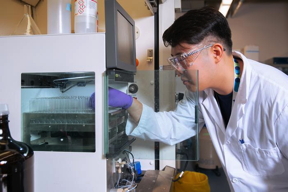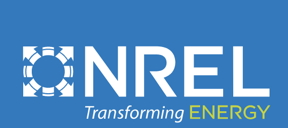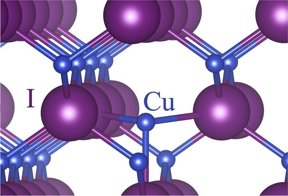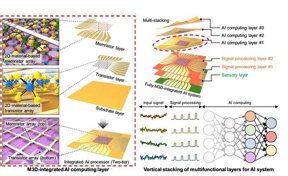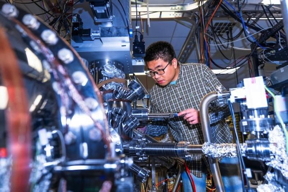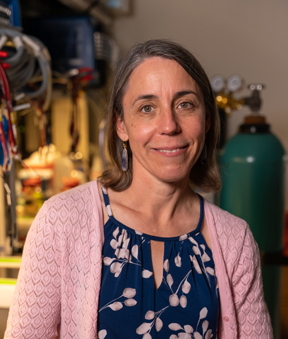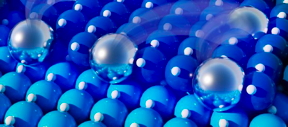Home > Press > Optically trapped quantum droplets of light can bind together to form macroscopic complexes
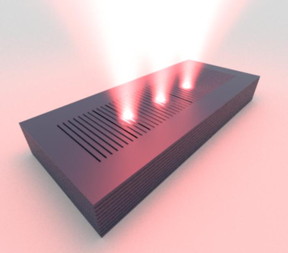 |
| Subwavelength grated waveguide supporting polariton droplets (visualization: Antonio Gianfrate, source: CNR Nanotec).
CREDIT |
Abstract:
Scientists from CNR Nanotec in Lecce and the Faculty of Physics at the University of Warsaw used a new generation of semiconductor photonic gratings to optically tailor complexes of quantum droplets of light that became bound together into macroscopic coherent states. The research underpins a new method to simulate and explore interactions between artificial atoms in a highly reconfigurable manner, using optics. The results have been published in the prestigious journal “Nature Physics”
Optically trapped quantum droplets of light can bind together to form macroscopic complexes
Warsaw, Poland | Posted on March 8th, 2024
Condensed matter systems and photonic technologies are regularly used by researchers to create microscale platforms that can simulate the complex dynamics of many interacting quantum particles in a more accessible setting. Some examples include ultracold atomic ensembles in optical lattices, superconducting arrays, and photonic crystals and waveguides. In 2006 a new platform emerged with the demonstration of macroscopically coherent quantum fluids of exciton-polaritons to explore many-body quantum phenomena through optical techniques.
When a piece semiconductor is placed between two mirrors – an optical microresonator – the electronic excitations within can become strongly influenced by photons trapped between the mirrors. The resulting new bosonic quantum particles, known as exciton-polaritons (or polaritons for short), can under the right circumstances undergo a phase transition into a nonequilibrium Bose-Einstein condensate and form a macroscopic quantum fluid or a droplet of light. Quantum fluids of polaritons have many salient properties, one being that they are optically configurable and readable, permitting easy measurements of the polariton dynamics. This is what makes them so advantageous to simulate many-body physics.
Polariton condensates must be continuously optically pumped with external lasers to replenish particles, otherwise the condensate dissipates within picoseconds. However, the harder you pump the condensate the more energetic it becomes due to repulsive interparticle forces, leading to particles escaping the condensate and subsequent decay of spatial correlations. This is a fundamental problem for optically programmable polariton simulators. Scientists needed to come up with a way to make the condensate more stable and long lived, while still being optically pumped.
Scientists from CNR Nanotec in Lecce and the Faculty of Physics at the University of Warsaw, achieved this goal using a new generation of semiconductor photonic gratings. In their paper titled “Reconfigurable quantum fluid molecules of bound states in the continuum”, published in Nature Physics, they used subwavelength properties of the photonic grating to imbue polaritons with new properties. First, the polaritons could be driven to condense into an ultralong lifetime state known as bound state in the continuum (BIC). The fascinating thing about BICs is that they are mostly non-radiative due to symmetry enforced protection from the outside continuum of photonic modes. Second, the polaritons obtained a negative effective mass due to the dispersion relation coming from the grating. This meant that the pumped polaritons could not escape so easily through normal decay channels anymore. Now, the researchers possessed polariton fluids that were both extremely long lived and safely confined using only optical techniques.
Combined, these mechanisms allowed Antonio Gianfrate and Danielle Sanvitto at CNR Nanotec in Lecce to optically pump multiple polariton droplets that could interact and hybridize into macroscopic complexes. They could tailor and reversibly configure molecular arrangements and chains using this new form of artificial atoms: condensates of negative-mass BIC polaritons. The BIC property provided polaritons with much longer lifetimes whereas the negative mass property caused them to become optically trapped. The findings were supported by a BIC Dirac-polariton theory developed between Helgi Sigurdsson (University of Warsaw), Hai Chau Nguyen (University of Siegen, Germany), and Hai Son Nguyen (Univ Lyon, France).
The ultimate advantage of the platform is that the artificial quantum complexes can be all-optically programmed yet they retain very high lifetimes because of their protection from the continuum. This could lead to a new venture into optically programmable large-scale quantum fluids defined by unprecedented coherence scales and stability for structured nonlinear lasing and polariton-based simulation of complex systems.
“There are still several interesting ways to explore in this artificial polaritonic Dirac system. As an example, the coupling mechanism between polariton droplets along and perpendicular to the grating direction is very different. Along the waveguide, polaritons are effectively negative mass particles strongly bound to their pump spot. Perpendicular to the waveguide they move as positive mass particles undergoing ballistic transport. The mixture of these two mechanisms opens a new window to look at emergent behaviours of synchrony and pattern formation in structured polariton quantum fluids” concludes Helgi Sigurðsson from the Faculty of Physics, University of Warsaw.
An international team of scientists conducted research supported by the National Science Center grant (2022/45/P/ST3/00467) co-funded by the European Union Framework Programme for Research and Innovation Horizon 2020 under the Marie Sklodowska-Curie grant agreement (No. 945339).
####
About University of Warsaw, Faculty of Physics
Physics and astronomy at the University of Warsaw appeared in 1816 as part of the then Faculty of Philosophy. In 1825, the Astronomical Observatory was established. Currently, the Faculty of Physics at the University of Warsaw consists of the following institutes: Experimental Physics, Theoretical Physics, Geophysics, the Department of Mathematical Methods and the Astronomical Observatory. The research covers almost all areas of modern physics, on scales from quantum to cosmological. The Faculty’s research and teaching staff consists of over 250 academic teachers. About 1,100 students and over 170 doctoral students study at the Faculty of Physics UW. The University of Warsaw is among the 150 best universities in the world educating in the field of physics according to the Shanghai’s Global Ranking of Academic Subjects.
For more information, please click here
Contacts:
Media Contact
Agata Meissner
University of Warsaw, Faculty of Physics
Office: 225-532-573
@physics_UW
Expert Contact
Dr Helgi Sigurdsson
Faculty of Physics University of Warsaw
Office: +48 22 55 32 765
@physics_UW
Copyright © University of Warsaw, Faculty of Physics
If you have a comment, please Contact us.
Issuers of news releases, not 7th Wave, Inc. or Nanotechnology Now, are solely responsible for the accuracy of the content.
| Related Links |
| Related News Press |
Quantum Physics
![]()
Researchers’ approach may protect quantum computers from attacks March 8th, 2024
![]()
Bridging light and electrons January 12th, 2024
News and information
![]()
Researchers develop artificial building blocks of life March 8th, 2024
Physics
![]()
Nanoscale CL thermometry with lanthanide-doped heavy-metal oxide in TEM March 8th, 2024
![]()
Scientists use heat to create transformations between skyrmions and antiskyrmions January 12th, 2024
![]()
Focused ion beam technology: A single tool for a wide range of applications January 12th, 2024
Superconductivity
![]()
‘Sudden death’ of quantum fluctuations defies current theories of superconductivity: Study challenges the conventional wisdom of superconducting quantum transitions January 12th, 2024
![]()
Researchers at Purdue discover superconductive images are actually 3D and disorder-driven fractals May 12th, 2023
Govt.-Legislation/Regulation/Funding/Policy
![]()
What heat can tell us about battery chemistry: using the Peltier effect to study lithium-ion cells March 8th, 2024
![]()
Researchers’ approach may protect quantum computers from attacks March 8th, 2024
![]()
Superbug killer: New synthetic molecule highly effective against drug-resistant bacteria February 16th, 2024
Possible Futures
![]()
Nanoscale CL thermometry with lanthanide-doped heavy-metal oxide in TEM March 8th, 2024
Optical computing/Photonic computing
![]()
New chip opens door to AI computing at light speed February 16th, 2024
![]()
HKUST researchers develop new integration technique for efficient coupling of III-V and silicon February 16th, 2024
![]()
NRL discovers two-dimensional waveguides February 16th, 2024
![]()
Thermal impact of 3D stacking photonic and electronic chips: Researchers investigate how the thermal penalty of 3D integration can be minimized December 8th, 2023
Discoveries
![]()
What heat can tell us about battery chemistry: using the Peltier effect to study lithium-ion cells March 8th, 2024
![]()
Researchers’ approach may protect quantum computers from attacks March 8th, 2024
![]()
High-tech ‘paint’ could spare patients repeated surgeries March 8th, 2024
![]()
Nanoscale CL thermometry with lanthanide-doped heavy-metal oxide in TEM March 8th, 2024
Announcements
![]()
What heat can tell us about battery chemistry: using the Peltier effect to study lithium-ion cells March 8th, 2024
![]()
Nanoscale CL thermometry with lanthanide-doped heavy-metal oxide in TEM March 8th, 2024
Interviews/Book Reviews/Essays/Reports/Podcasts/Journals/White papers/Posters
![]()
Researchers develop artificial building blocks of life March 8th, 2024
![]()
Nanoscale CL thermometry with lanthanide-doped heavy-metal oxide in TEM March 8th, 2024
Photonics/Optics/Lasers
![]()
Nanoscale CL thermometry with lanthanide-doped heavy-metal oxide in TEM March 8th, 2024
![]()
HKUST researchers develop new integration technique for efficient coupling of III-V and silicon February 16th, 2024
![]()
A battery’s hopping ions remember where they’ve been: Seen in atomic detail, the seemingly smooth flow of ions through a battery’s electrolyte is surprisingly complicated February 16th, 2024
![]()
NRL discovers two-dimensional waveguides February 16th, 2024
Quantum nanoscience
![]()
Bridging light and electrons January 12th, 2024
![]()
‘Sudden death’ of quantum fluctuations defies current theories of superconductivity: Study challenges the conventional wisdom of superconducting quantum transitions January 12th, 2024
![]()
What a “2D” quantum superfluid feels like to the touch November 3rd, 2023
- SEO Powered Content & PR Distribution. Get Amplified Today.
- PlatoData.Network Vertical Generative Ai. Empower Yourself. Access Here.
- PlatoAiStream. Web3 Intelligence. Knowledge Amplified. Access Here.
- PlatoESG. Carbon, CleanTech, Energy, Environment, Solar, Waste Management. Access Here.
- PlatoHealth. Biotech and Clinical Trials Intelligence. Access Here.
- Source: http://www.nanotech-now.com/news.cgi?story_id=57457
- :is
- :not
- :where
- $UP
- 1
- 10
- 100
- 12th
- 150
- 16th
- 2006
- 2020
- 22
- 250
- 27
- 30th
- 32
- 3d
- 3rd
- 4
- 55
- 7
- 7th
- 8th
- a
- About
- academic
- access
- accessible
- According
- accuracy
- achieved
- actually
- advanced
- ADvantage
- advantageous
- against
- Agreement
- AI
- All
- allowed
- almost
- along
- among
- an
- and
- anymore
- appeared
- approach
- ARE
- areas
- arrangements
- artificial
- AS
- astronomy
- At
- battery
- BE
- Beam
- became
- because
- become
- becomes
- been
- behaviours
- being
- BEST
- Better
- between
- BIC
- bind
- Blocks
- both
- bound
- Brazilian
- breakthrough
- Building
- by
- CAN
- caused
- Center
- CGI
- chains
- challenges
- channels
- characteristic
- chemistry
- chip
- Chips
- circumstances
- click
- COHERENT
- COM
- come
- coming
- comment
- complex
- computers
- computing
- concludes
- conducted
- Confirm
- consists
- content
- continuously
- Continuum
- conventional
- correlations
- could
- covers
- create
- credit
- crucial
- Current
- Currently
- Danielle
- de
- Death
- December
- defined
- del
- demonstration
- Department
- Derivatives
- detail
- develop
- developed
- different
- direction
- discover
- Discovers
- Dispersion
- Door
- driven
- due
- dynamics
- easily
- easy
- educating
- effect
- Effective
- effectively
- efficient
- electrolyte
- Electronic
- emerged
- end
- energetic
- enforced
- escape
- established
- Ether (ETH)
- European
- european union
- example
- examples
- experimental
- explore
- external
- extremely
- fascinating
- February
- feels
- field
- findings
- First
- first time
- flow
- fluctuations
- fluid
- following
- For
- Forces
- forcing
- form
- formation
- formulation
- Framework
- frameworks
- France
- from
- fundamental
- future
- generation
- Germany
- gif
- Global
- goal
- grant
- harder
- Have
- Health
- High
- highly
- horizon
- How
- However
- HTML
- http
- HTTPS
- if
- images
- Impact
- in
- Inc.
- include
- individual
- inflammation
- influenced
- information
- Innovation
- Institute
- integration
- interact
- interacting
- interactions
- interesting
- International
- into
- investigate
- involving
- IT
- January
- journal
- june
- killer
- kirk
- known
- large-scale
- lasers
- lead
- leading
- Leads
- lifetime
- light
- like
- links
- Long
- longer
- Look
- Lyon
- make
- MAKES
- manner
- many
- March
- maria
- Mass
- materials
- mathematical
- Matter
- May..
- meant
- measurements
- mechanism
- mechanisms
- method
- methods
- Milena
- million
- mixture
- Modern
- modes
- molecular
- molecule
- more
- mostly
- move
- much
- multiple
- must
- nanotechnology
- National
- National Science
- Nature
- needed
- negative
- net
- New
- New Platform
- news
- Nguyen
- no
- nonlinear
- normal
- novel
- November
- now
- observatory
- obtained
- of
- on
- ONE
- only
- opens
- optical
- optics
- or
- otherwise
- outside
- over
- overall
- paint
- pandemic
- Paper
- part
- patients
- Pattern
- phase
- philosophy
- Photons
- PHP
- Physics
- piece
- placed
- platform
- Platforms
- plato
- Plato Data Intelligence
- PlatoData
- please
- Poland
- positive
- possibilities
- Post
- posted
- press
- Press Release
- prestigious
- princeton
- Problem
- processing
- programmable
- programme
- programmed
- properties
- property
- protect
- protection
- proved
- provided
- published
- pump
- Quantum
- quantum computers
- quantum computing
- quantum information
- quantum particles
- range
- Ranking
- receives
- regularly
- relation
- release
- Releases
- remember
- repeated
- replenish
- research
- research and innovation
- researchers
- responsible
- resulting
- Results
- retain
- return
- right
- robust
- s
- safely
- Save
- scales
- Science
- scientists
- Search
- Second
- seemingly
- seen
- semiconductor
- setting
- several
- Share
- Short
- significant
- simulate
- simulation
- single
- smooth
- So
- Soft
- solely
- some
- son
- Source
- Spatial
- Spot
- Stability
- stable
- stacking
- Staff
- start
- State
- States
- Still
- strongly
- structured
- Students
- Study
- submit
- subsequent
- sudden
- Superconductivity
- Supported
- Supporting
- Surface
- surprisingly
- symmetry
- synthetic
- system
- Systems
- tailor
- teachers
- Teaching
- team
- technique
- techniques
- Technologies
- Technology
- tell
- tested
- tests
- that
- The
- the world
- their
- Them
- then
- theoretical
- theory
- thermal
- These
- they
- thing
- this
- Through
- time
- titled
- to
- together
- tool
- transformations
- transition
- transport
- trapped
- treatment
- two
- ultimate
- under
- undergo
- undergoing
- union
- Universal
- Universities
- university
- unprecedented
- us
- use
- used
- using
- venture
- very
- visualization
- W
- Warsaw
- was
- Water
- Wave
- Way..
- ways
- were
- What
- whereas
- while
- wide
- Wide range
- window
- wisdom
- with
- within
- Work
- world
- Yahoo
- yet
- you
- zephyrnet










